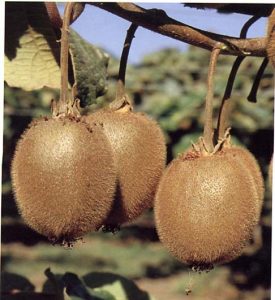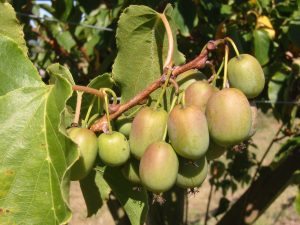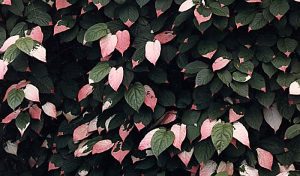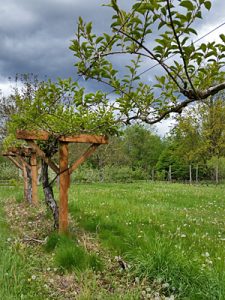Plant of the Week- Actinidia sp. or Kiwis
Kiwis, kiwifruit, and Chinese gooseberry are some the common names for the fruit of vines of the genus Actinidia. In the produce section of most supermarkets, the kiwifruit found is the fruit of the Fuzzy Kiwi, or Actinidia deliciosa. Saanichton is the selection of this species that can fruit well in the Pacific Northwest climate. Slightly hardier than the more commercial Hayward cultivar, Saanichton is productive in warmer areas of Western Washington.
- Ana Kiwi
- Kolomitka male kiwi foliage
- Kiwi Trellis
Saanichton must be planted with a male Actinidia deliciosa vine for pollination. Actinidia is a dioecious plant: male and female flowers are produced on separate plants. To cross-pollinate, interplant male vines with the female fruit producing vines. Pollen from one male vine can pollinate up to eight surrounding female vines. Vines do not begin to bear fruit until they have grown for 4 or more years. Maximum production is attained at about 8 years.
Easier to grow in our climate are the hardy kiwis, or selections of Actinidia arguta. The female vines of this species produce a large grape-sized fruit that is smooth skinned. The vines in this group are very winter hardy. Ana (Ananasnaja) and Jumbo are the most common female cultivars, and very reliable. Slightly early ripening is 74-49. Another cultivar, Hardy Red, has red flesh instead of the usual green.
Even hardier are selections of Actinidia kolomitka. Hardy to -40F, these vines produce the smallest kiwis, but they are very sweet. This group is often planted for their ornamental variegated leaves, splashed pink and white.
Kiwis prefer rich, well-drained soil with ample summer water. When planting kiwis, the best site is one that is not subject to early fall freezes or late spring frosts. The trunks of the fuzzy kiwi vines are the most susceptible to winter damage and can be protected by wrapping them in the winter. Neither home nor commercial growers of kiwi in the Pacific Northwest have reported any serious insect or disease problems.
Kiwi vines are very vigorous growers and require a sturdy trellis system. The best trellis for ease of harvest and pruning for the home gardener is a 6-foot T-bar trellis made of treated post set in concrete. Space three to five 12-gauge horizontal wires at 1- to 1.5-foot
intervals and space plants 15 to 20 feet apart within the trellis. A typical T-bar trellis consists of posts with a 5- to 6-foot (depending on row width) long cross arm extending across the post. The kiwi fruiting canes are tied to wires on top of the cross arm. Kiwi fruit on shoots that grow from last year’s canes. Renewal pruning is essential to keeping the vines productive. For a full description of kiwi pruning, download Success with Kiwis from our website.






Dear Shawn and Hilary ,
Hi,
Happy 4th July
Are kiwi hardy in colder regions like zones 5 ?
Sincerely,
The arguta and kolomitka groups of kiwis are hardy to -25°F and -40°F respectively. These are the kiwis whose fruit is grape sized and has no fuzz.